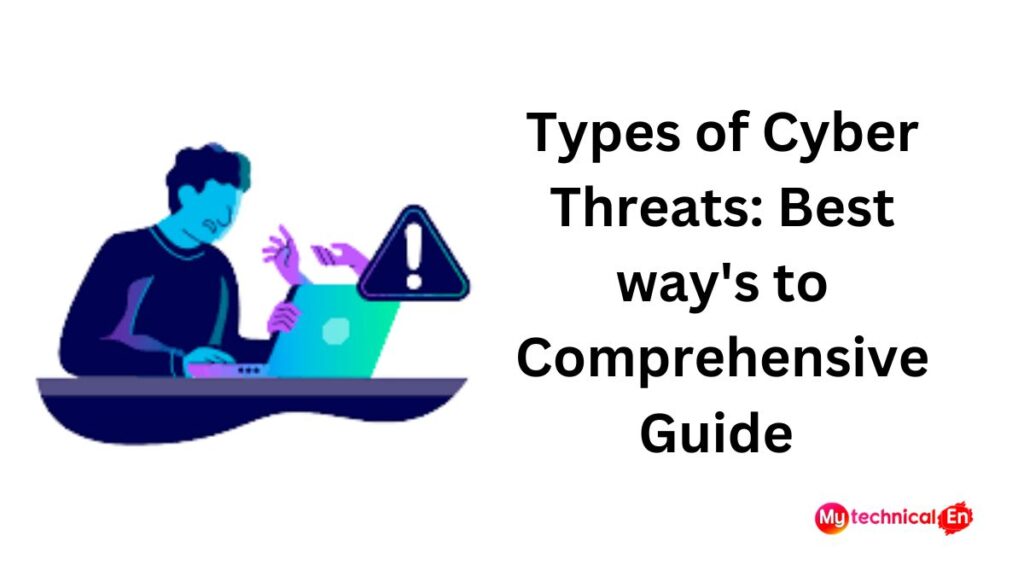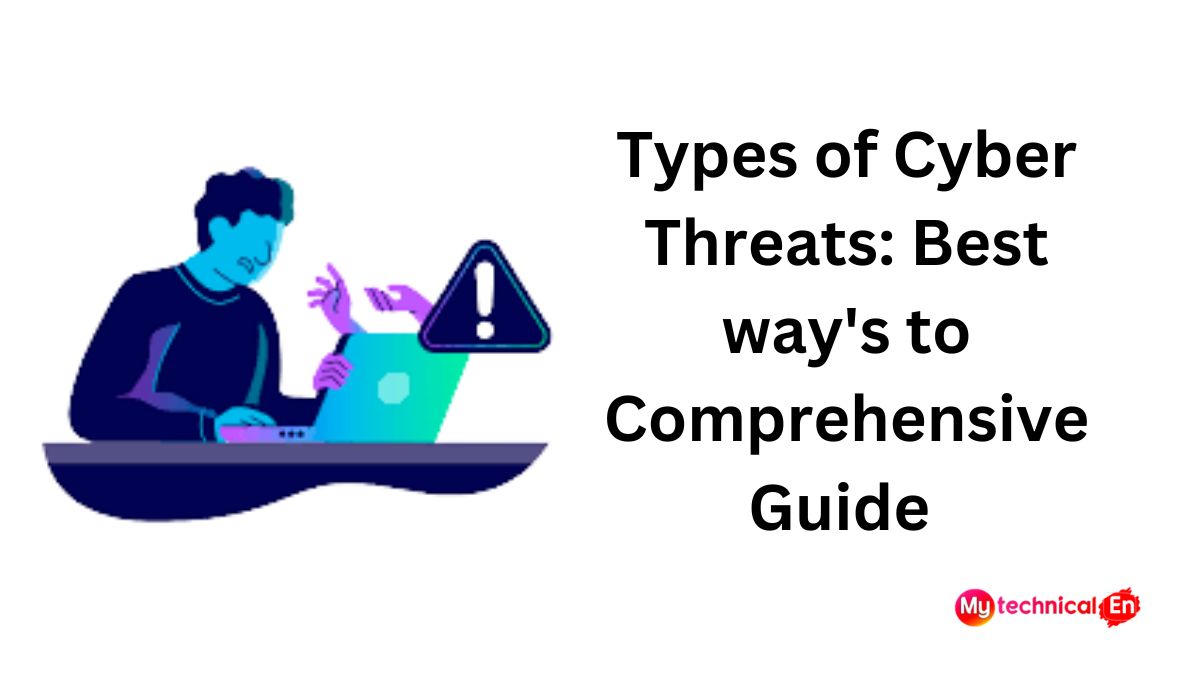In today’s digitally driven world, where technology has become an integral part of our lives, the prevalence of cyber threats has surged. Understanding the various types of cyber threats is crucial for safeguarding personal and organizational information. This comprehensive guide will delve into the world of cyber threats, providing valuable insights and expert advice.

Types of Cyber Threats
Malware: The Silent Invader
Malware, cyberattack short for malicious software, is a broad category of cyber threats. It encompasses viruses, worms, Trojans, and ransomware, among others. These malicious programs can infiltrate your system, causing data breaches, financial loss, and system disruptions.
Phishing: Hook, Line, and Sinker
Phishing attacks rely on deception. Cybercriminals pose as trustworthy entities, such as banks or government agencies, to trick individuals into revealing sensitive information like passwords and credit card details. Vigilance is key to avoiding these traps.
DDoS Attacks: Overwhelming the Defenses
Distributed Denial of Service (DDoS) attacks flood a target’s server with traffic, rendering it inaccessible. Hackers use networks of compromised devices to execute these attacks. Organizations must invest in robust defenses to mitigate DDoS threats.
Insider Threats: The Danger Within
Sometimes, the biggest threats come from within an organization. Employees with malicious intent or those inadvertently compromising security can be a significant risk. Effective employee training and strict access controls are vital.
Zero-Day Exploits: The Unknown Vulnerability
Zero-day exploits target undisclosed vulnerabilities in software or hardware. Cybercriminals exploit these security gaps before developers can create patches. Staying up-to-date with security updates is essential.
Ransomware: Holding Data Hostage
Ransomware encrypts a victim’s data, demanding a ransom for decryption. Falling victim to a ransomware attack can be financially crippling. Regular backups and security measures can mitigate the risk.
Social Engineering: Manipulating Trust
Social engineering attacks exploit human psychology to gain access to sensitive information. These attacks can be challenging to defend against, making user education crucial.
IoT Threats: Vulnerabilities in Smart Devices
The Internet of Things (IoT) has brought convenience, but it has also introduced security risks. Inadequately secured smart devices can become entry points for cybercriminals.
State-Sponsored Attacks: Geopolitical Cyber Warfare
Nation-states engage in cyber warfare to steal information, disrupt services, or gain a strategic advantage. These attacks are highly sophisticated and often have severe consequences.
Certainly! Let’s continue with more content on Types of Cyber Threats:
Protecting Yourself Against Cyber Threats
In today’s digital age, the importance of cybersecurity cannot be overstated. With cyber threats becoming increasingly sophisticated, it’s crucial to take proactive steps to protect yourself and your organization. Here are some practical tips to enhance your cybersecurity posture:
1. Stay Informed
Knowledge is your first line of defense. Keep yourself updated on the latest cyber threats, trends, and vulnerabilities. Follow cybersecurity news, blogs, and official announcements to stay informed about potential risks.
2. Use Strong Passwords
Weak passwords are an open invitation to cybercriminals. Create strong, unique passwords for each online account, and consider using a reputable password manager to keep track of them. Enable two-factor authentication wherever possible for an added layer of security.
3. Keep Software Updated
Cybercriminals often exploit known vulnerabilities in outdated software. Regularly update your operating system, applications, and antivirus software to patch security holes. Configure automatic updates whenever possible.
4. Be Cautious of Emails and Links
Phishing emails remain a prevalent threat. Exercise caution when opening emails from unknown senders, and never click on suspicious links or download attachments from unverified sources. Verify the legitimacy of emails, especially those requesting sensitive information.
5. Back Up Your Data
Regular data backups are essential to mitigate the impact of ransomware attacks. Store backups offline or in a secure cloud storage solution. Test your backups periodically to ensure they can be restored.
6. Educate Yourself and Others
Educate yourself and your colleagues or family members about cybersecurity best practices. Conduct training sessions to raise awareness of common threats and teach safe online behavior.
7. Implement Network Security
For organizations, robust network security measures are critical. This includes firewalls, intrusion detection systems, and encryption protocols to protect sensitive data in transit. Regularly audit and assess your network security posture.
8. Monitor Your Digital Footprint
Limit the amount of personal information you share online. Cybercriminals often gather information from social media and other online sources to tailor their attacks. Review and adjust your privacy settings on social media platforms.
9. Report Suspicious Activity
If you encounter any suspicious online activity or believe you’ve been a victim of a cyber attack, report it to the relevant authorities or your organization’s IT department immediately. Timely reporting can help mitigate the damage.
10. Seek Professional Help
Consider hiring cybersecurity professionals or consultants to assess your organization’s security infrastructure and recommend improvements. They can perform vulnerability assessments and penetration testing to identify weaknesses.
By taking these proactive measures, you can significantly reduce your risk of falling victim to various types of cyber threats. Remember that cybersecurity is an ongoing process, and staying vigilant is essential to protect yourself and your digital assets.
Must read:-
- What Are Internet Cookies? Best way’s to defination in 2023
- What is Network Firewall Security? | Best way’s to Safeguarding Your Digital Domain in 2023
- What Are Internet Cookies? Best way’s to defination in 2023
Frequently Asked Questions (FAQs)
Q: How can I protect myself from phishing attacks?
A: Be cautious of unsolicited emails or messages, verify the sender’s authenticity, and never share sensitive information through unsecured channels.
Q: What is the best defense against malware?
A: Utilize reputable antivirus software, keep your operating system and applications updated, and exercise caution when downloading files or clicking on links.
Q: Are small businesses vulnerable to cyber threats?
A: Yes, small businesses are often targeted because they may have less robust cybersecurity measures. Implementing cybersecurity best practices is essential for all businesses, regardless of size.
Q: How can individuals safeguard their IoT devices?
A: Change default passwords, update device firmware regularly, and segment your network to isolate IoT devices from critical systems.
Q: What motivates state-sponsored cyberattacks?
A: State-sponsored attacks can have various motivations, including espionage, sabotage, or gaining a strategic advantage in geopolitics.
Q: Is it possible to recover data after a ransomware attack without paying the ransom?
A: In some cases, data recovery without paying the ransom is possible through backups or decryption tools. However, prevention is the best strategy.
Conclusion
As the digital landscape continues to evolve, so do the types of cyber threats. Staying informed and vigilant is paramount in defending against these ever-present dangers. By understanding the various threats and implementing proactive cybersecurity measures, individuals and organizations can protect themselves in an increasingly interconnected world.
